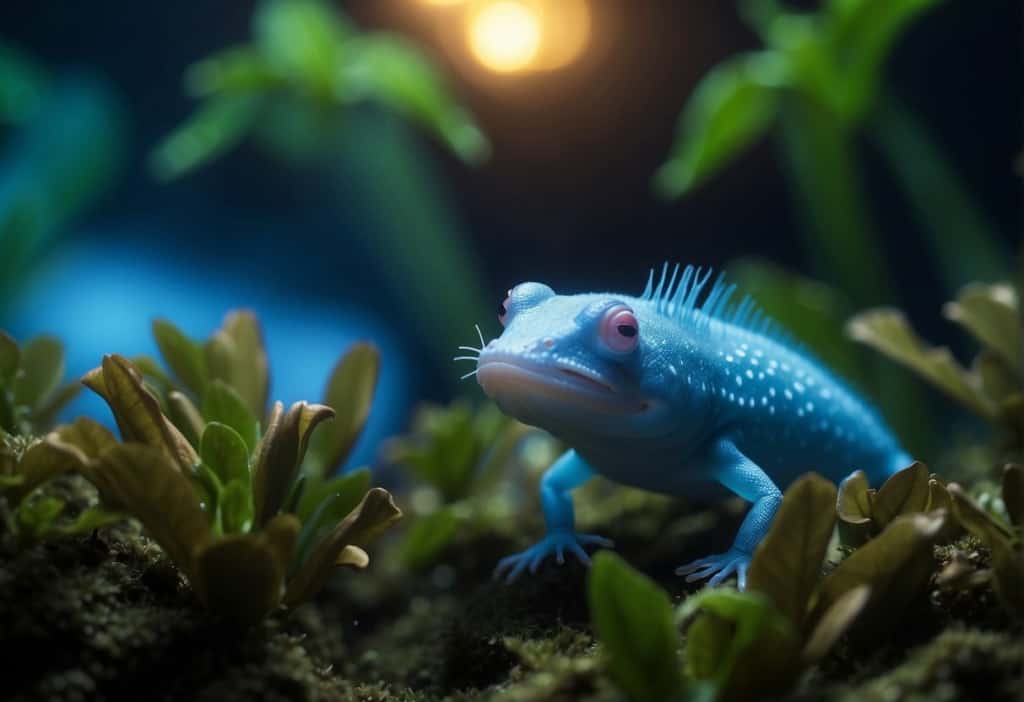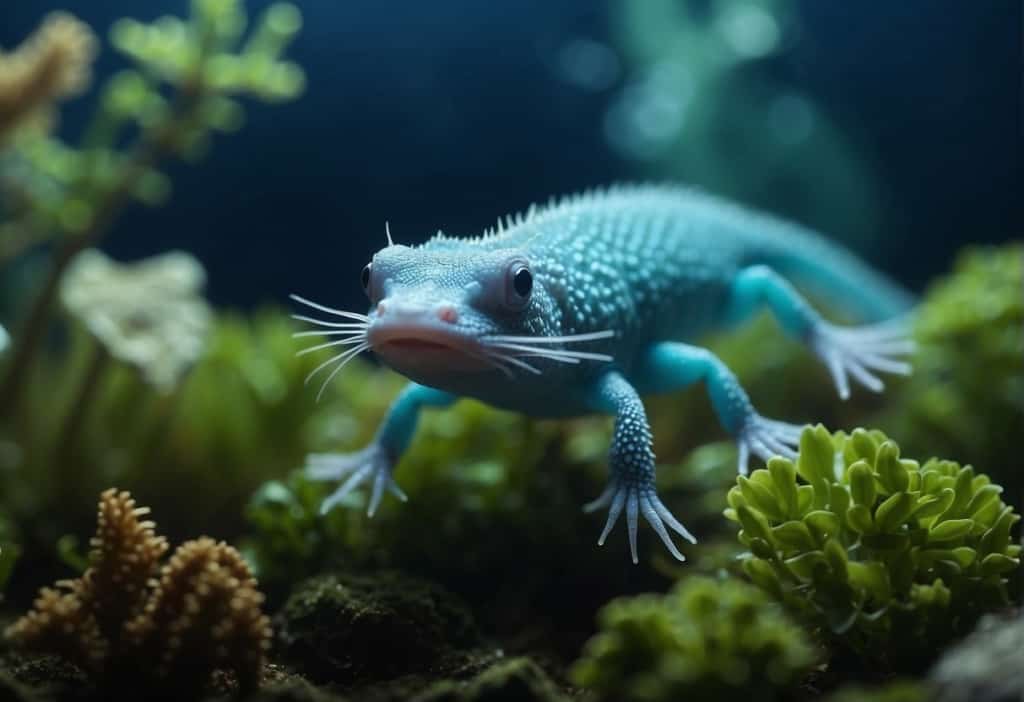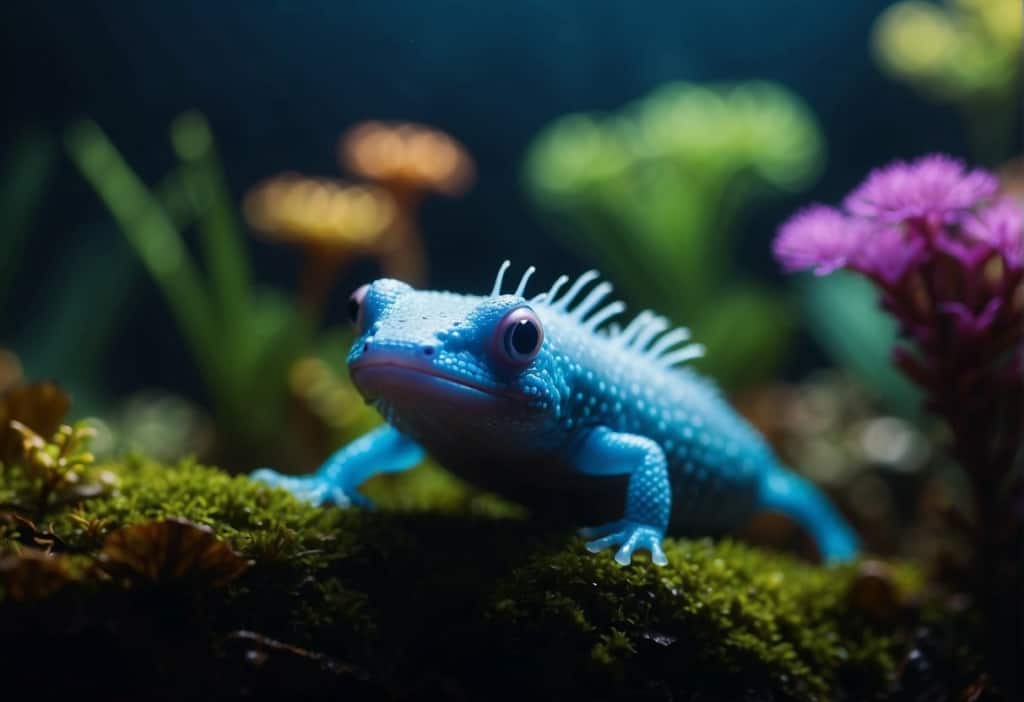Blue Neon Axolotl: Unveiling the Aquatic Wonder of Our Time
The blue neon axolotl, a stunning variation of Ambystoma mexicanum, is a captivating creature with its unique coloration and striking appearance. Known for their remarkable regenerative abilities, axolotls are excellent subjects for scientific research and have become popular in the pet trade due to their striking colors and fascinating biology. The blue neon axolotl is one such color variant that attracts attention and piques interest in both the scientific community and among hobbyists.

Although axolotls are generally found in shades of brown, beige, or green, the blue neon variety is a remarkable result of selective breeding and genetic factors.
These creatures have a unique mix of pigment cells, known as chromatophores, that create the appearance of glowing blue neon color under specific lighting conditions.
The captivating coloration of the blue neon axolotl, combined with its easy-going nature, makes it a sought-after pet, especially for those with a penchant for exotic and unique creatures.
Key Takeaways
- Blue neon axolotls are a striking color variant of the Ambystoma mexicanum species known for their captivating appearance.
- The unique coloration of blue neon axolotls is due to a mix of chromatophores and specific genetic factors.
- Caring for a blue neon axolotl requires understanding its biology, providing the right tank conditions, and addressing challenges related to breeding and maintenance.
Understanding Axolotls

Biology and Species Classification
The axolotl (Ambystoma mexicanum) is a unique type of salamander known for its striking appearance and incredible regenerative abilities. The axolotl belongs to the family Ambystomatidae, which is comprised of mole salamanders. Some features that set the axolotl apart from other salamanders include:
- External gills: Axolotls have long, feathery gills that protrude from the sides of their heads.
- Neoteny: Axolotls retain their larval characteristics throughout their lives and do not undergo a typical metamorphosis.
In recent years, a variation known as the blue neon axolotl has garnered attention due to its vibrant coloration, which is caused by a combination of genetic factors and pigmentation.
Habitat and Natural Environment
Axolotls are native to the Xochimilco region of Mexico, where they inhabit a network of slow-moving canals, wetlands, and freshwater lakes. This habitat provides axolotls with the necessary conditions for survival, including:
- Shallow water with a depth of 1-3 meters
- Abundant aquatic plants for hiding and hunting
- Muddy bottoms for burrowing
As a result of urbanization and pollution, the axolotl’s natural habitat is rapidly shrinking, resulting in a decline in their wild population. For this reason, axolotls are considered a critically endangered species. Nowadays, they are more commonly found in home aquariums and research labs, where their remarkable regenerative abilities are studied.
By understanding the axolotl’s natural habitat and their unique biology, you can appreciate why these fascinating creatures have captivated the hearts and minds of researchers, pet owners, and conservationists alike.
Neon and Biofluorescence
Principles of Neon Coloring
Neon coloring is a result of light emission or reflection that is brighter and more saturated than nearby colors. In the case of the blue neon axolotl, their vibrant appearance is due to the combination of neon pigments and biofluorescence. Neon pigments can be found in various organisms, including aquatic creatures like the axolotl. Sometimes, the bright neon is not just visually appealing but also plays a role in communication and camouflage.
Biofluorescence in Aquatic Creatures
Biofluorescence is the ability of an organism to absorb light at one wavelength and re-emit it at a longer wavelength, usually resulting in a colorful glow. This phenomenon has been observed in several aquatic creatures, including the axolotl. When exposed to a certain type of light, such as ultraviolet (UV) light or LED light, axolotls exhibit a glowing effect due to their biofluorescence.
Here are some examples of biofluorescent creatures:
- Blue neon axolotl
- Neon green gecko
- Certain species of fish and corals
To better understand the difference between neon and biofluorescence, consider these key points:
- Neon pigments are responsible for the vibrant coloration in organisms like the blue neon axolotl.
- Biofluorescence occurs when organisms absorb and re-emit light, creating a glowing effect.
- Both factors can contribute to camouflage or communication within aquatic environments.
In conclusion, the impressive and eye-catching appearance of the blue neon axolotl is thanks to a combination of vibrant neon pigments and biofluorescence. This remarkable trait helps these creatures stand out, communicate, and survive in their vibrant aquatic world.
Blue Neon Axolotl Care
Aquarium Setup
To properly care for your blue neon axolotl, it’s crucial to set up an appropriate aquarium. Axolotls are aquatic creatures, so you need to provide them with a spacious axolotl tank. The tank should be:
- At least 20 gallons for one axolotl
- Maintaining a water temperature around 60-68°F (16-20°C)
- Equipped with a filtration system to keep water clean
- Decorated with hiding spots like caves and plants
Keep the tank away from direct sunlight and noise to help reduce stress levels in the glow blue neon axolotl.
Diet and Feeding
Feeding your blue neon axolotl a balanced diet is key to keeping them healthy. They mainly feed on live food and should be given a mix of:
- Earthworms
- Bloodworms
- Brine shrimp
- Soft pellet food (specifically formulated for axolotls)
Feed juvenile axolotls daily, and adult axolotls can be fed every other day. Adjust the feeding schedule according to your axolotl’s needs. Remember to not overfeed, as it can lead to health issues. Remove any uneaten food promptly to keep the water clean.
Health Monitoring
Regularly monitoring your axolotl’s health is essential for proper care. Watch for any signs of illness or distress, such as:
- Lethargy – not moving or unmotivated to swim
- Loss of appetite – not eating or showing disinterest in food
- Visible wounds or skin abnormalities
If you notice any concerning symptoms, consult a specialist for proper treatment. By providing an adequate aquarium setup, a well-balanced diet, and close health monitoring, you will ensure a comfortable and healthy environment for your blue neon axolotl.
Breeding and Genetics
Blue Neon Axolotl Breeding
Breeding Blue Neon Axolotls can be an exciting experience. These unique amphibians are known for their captivating, vibrant colors and interesting appearance. When breeding these axolotls, you should provide a suitable environment to ensure their health and well-being. Some factors to consider are:
- Appropriate tank size for the number of axolotls.
- Clean water with proper filtration.
- Comfortable water temperature and pH levels.
It is important to note that the GFP (green fluorescent protein) gene has been introduced to some axolotls, causing them to exhibit a glow-like effect under specific lighting conditions. This extra glow can add a layer of fascination when breeding and observing your Blue Neon Axolotls.
Genetic Factors of the Neon Trait
The impressive neon trait found in Glow Blue Neon Axolotls is attributed to specific genetic factors. While the precise mechanisms have not been fully identified, certain genetic mutations, such as the presence of the GFP gene, impact their coloration and overall appearance.
Axolotl genetic traits can be inherited through selective breeding, allowing breeders to produce offspring that possess the vibrant neon color and other desired attributes. By understanding and controlling the genetic factors, breeders can help to maintain the Blue Neon Axolotl population and continue to study these fascinating creatures.
Remember, when breeding your Blue Neon Axolotls, it is essential to be informed about their genetic traits and provide them with the ideal environment to ensure the health and well-being of these mesmerizing amphibians.
Axolotls In Popular Culture

Axolotls In Gaming
Blue neon axolotls have found their way into the gaming world, capturing the attention of players with their vibrant colors and unique appearance. One popular platform where you can find axolotl-inspired characters and items is Roblox.
In Roblox, you can find various games and virtual items featuring this fascinating amphibian. Here are a few examples of axolotl-themed content in Roblox:
- Blue neon axolotl pets
- Axolotl plushies
- Axolotl clothing and accessories
Neon Axolotls as Artistic Motifs
The blue neon axolotl is not only popular in the gaming world but also serves as an inspiration for artistic endeavors. One way this creature is showcased is through axolotl neon signs. These customizable signs can be made in various colors, including the eye-catching blue neon hue often associated with axolotls.
In addition, the blue neon axolotl can be found in other artistic expressions like:
- Digital art and illustrations
- Tattoos
- Logo designs
- Sculptures
- Street art
As you can see, blue neon axolotls have captivated the hearts of gamers and artists alike, inspiring various forms of creative expression. With their mesmerizing colors and endearing appearance, it’s no wonder that axolotls continue to make a splash in popular culture.
Acquiring a Blue Neon Axolotl
Selecting a Healthy Specimen
When looking for a Blue Neon Axolotl, it’s essential to choose a healthy specimen. Keep an eye out for key indicators of health, such as:
- Bright, clear eyes
- Confirm that all limbs are intact
- A straight and firm tail
- Healthy, functioning gills
- Steady swimming behavior
Additionally, it is crucial that your potential pet has a good appetite and maintains a suitable size for its age.
Sources and Availability
While finding axolotls for sale might seem challenging at first, there are resources available to help you in your search. One place to start is by researching Where to Buy an Axolotl: A Complete Guide for the First-time Buyer, which offers guidance on connecting with breeders.
Consider reaching out to one of the many breeders specializing in Blue Neon Axolotls:
- Local pet shops with an exotic amphibian section
- Reputable online vendors
- Social media groups related to axolotls
To ensure a positive experience, prioritize breeders that are well-regarded and responsible in their practices. This can include them selling neon variants and showcasing transparency in their breeding methods. By taking your time and doing thorough research, you will be able to acquire a healthy Blue Neon Axolotl to welcome into your home as a fascinating and captivating pet.
Challenges and Considerations
Potential Health Issues
A crucial aspect of blue neon axolotl care involves being aware of potential health issues. If your axolotl is gasping for air, it may be experiencing respiratory distress. In such cases, seeking the help of a veterinarian is necessary.
To ensure your axolotl remains healthy, consider the following recommendations:
- Maintain optimal water quality by performing regular water changes and testing for ammonia, nitrite, and nitrate levels.
- Keep water temperature between 60-68°F (16-20°C).
- Feed a varied diet, including high-quality pellets, live or frozen foods like bloodworms and brine shrimp.
By providing proper care, you are more likely to keep your axolotl healthy.
Ethical Aspects of Axolotl Ownership
Before deciding to own a blue neon axolotl, it’s essential to consider ethical aspects related to their care and treatment. Here are some key points to keep in mind:
- Axolotls are exotic pets and may have specific care requirements that differ from regular aquatic pets.
- Ensure you are prepared for long-term commitment; axolotls can live up to 15 years with proper care.
- Purchasing axolotls from reputable breeders helps ensure the animals come from responsible practices.
By being aware of these challenges and considerations, you can make informed decisions about blue neon axolotl ownership and provide the best care for your pet.
- Note: AI created the Images for this article because we did not have the access to photograph an actual Blue Neon Axolotl.
